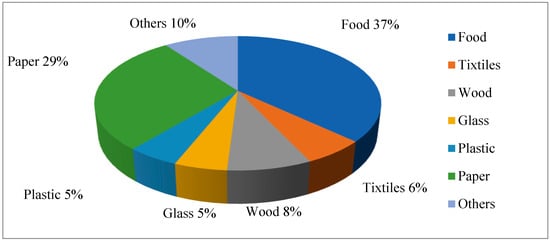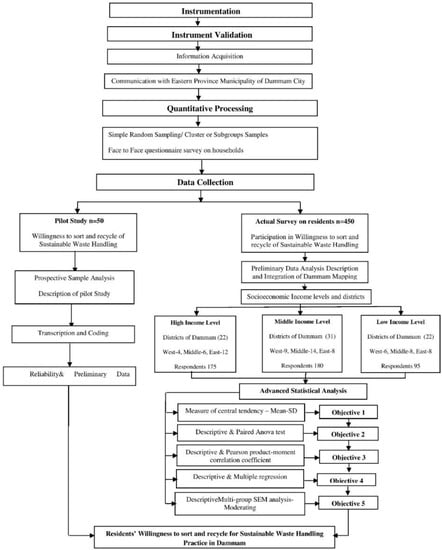You're using an outdated browser. Please upgrade to a modern browser for the best experience.
Please note this is an old version of this entry, which may differ significantly from the current revision.
Subjects:
Environmental Sciences
There was a statistically significant difference between low and high levels of awareness and perceived behavior control in Dammam City households’ willingness to sort waste and recycle; however, at the middle level, there was only a significant difference in perceived behavior control. Moreover, there was a statistically significant difference between high and middle levels in government facilitators regarding sorting and recycling willingness in Dammam City.
- socio-psychological factors
- willingness
- waste sorting and recycling
- Dammam City
1. Introduction
Accelerated and continuous growth in the urban population has caused an increase in municipal solid waste (MSW) generation, which, consequently, has a serious environmental and socio-economic impact. Municipal solid waste (MSW) is defined as solid wastes that are produced from different environments such as from public places, offices, households, and hospitals, which are related to the governmental responsibilities of municipal waste for collection, transportation, and final disposal [1]. The improper handling and disposal of waste is a growing concern as the amount of waste generation increases worldwide [1,2,3]. Annually, Saudi Arabia generates 1.5–1.8 billion metric tons of MSW, with the per capita waste generation estimated to range from 1.5 to 1.8 kg per person per day, indicating the magnitude of the problem that civic bodies face. Moreover, it has been estimated that this will increase to about 25 billion tons by 2050 [4,5].
Currently, Dammam City, which is a major city in the Eastern Province, has an increasing population with a growth rate of about 4.1%. In 2020, the population of Dammam was estimated to be around 1.2 million [6,7]. There are various municipal solid waste types (MSWs). Typically, organics comprise a major portion (40%) of solid waste, of which food waste is the most prominent waste stream (50.6%). Food waste comprises 37% of solid waste generation in KSA [8]. Food waste contains rice (38.7%), meat (25%), bakery products (18.7%), and fats (13%) [9]. Wood is the second largest, and plastic is the third largest stream. However, other components in the waste stream include textiles (6%), glass (5%), and minerals (8.1%) [10]. Figure 1 shows the composition of solid waste in Saudi Arabia.

Figure 1. Different percentages of Solid Waste Generation in Saudi Arabia.
Some factors cause an increase in waste generation, such as urbanization and industrialization changes in consumption patterns and lifestyle, which have a harmful effect on public health and the environment [11,12,13]. The government of Saudi Arabia realized that a permanent solution to the issues of solid waste management must be found to achieve reducing of the solid waste accumulation with its benefiting. Regarding the national budget for the year 2017, the government allocated a huge amount of money (54 billion Saudi riyals) for public municipal services, including solid waste disposal. The Saudi government has been keen to encourage participation in sustainable solid waste recycling programs by creating resident awareness and providing financial support and modern technologies under strong regulations and legislations governing solid waste management under the supervision of the Ministry of Municipal and Rural Affairs to ensure implementation and integrated success [14].
2. The influence of Socio-Psychological Factors on Residents’ Willingness to Practice Sustainable Waste Handling in Dammam City, Saudi Arabia
Solid waste management provides the essential services of collecting, storing, and transporting and offers solutions to treat aesthetic, conservation, economic, and public health considerations. Solid waste management relates to how solid waste can be utilized as a resource. Every household and business owner across the world should engage in proper solid waste management ([15,16,17]. The main idea behind waste handling is the repurposing of waste produced as a product for use as raw material in certain industries, such as plastic, which is considered the third largest solid waste stream in Saudi Arabia. However, only 15–20% of plastic waste is recyclable through segregation, and most of it is disposed of in landfills. Therefore, pyrolysis is used as a plastic treatment and power generation method in the form of fuel oil and valuable products such as coal [4,9,18,19,20].
Improper waste handling practices are responsible for the second highest share of greenhouse gas emissions (GHGE) (CO2, CH4, N2O) aside from fossil fuels [10,21]. It was forecast that most of the dumping sites in the country may likely reach their capacities in the coming few years, which indicates the need to change from current waste management practices to sustainable waste management practices such as waste separation and recycling approaches [6].
Hornik, in 1995, assumed that economic incentives can only be used for participation in solid waste sorting and recycling in the short run. Social and psychological factors are effective means that have been used to urge citizens to recycle waste by creating environmental awareness and providing facilities for solid waste recycling [22,23,24]. Positive changes in their behavior depend on how they perceive differences in an individual’s social and psychological background, which influence their decision to participate in waste sorting and recycling. Therefore, significant effort is required to motivate and enlighten people to understand and appreciate the importance of practicing responsible and sustainable waste management as well as managing their waste more sustainably by sorting and recycling waste at the source [25].
Previous literature on the recycling of household solid waste has mainly focused on how to recycle waste according to certain criteria, including changing societal behavior to understand what is meant by recycling waste, as well as how to develop plans for how to properly handle waste, and that there should be cooperation between the formal and informal sectors in a manner that is consistent with the unification of solid waste [26,27,28]. However, few studies have examined the influence of psychological factors that influence recycling behavior to determine residents’ willingness to engage in waste management [29,30].
Saudi Arabia has faced challenges caused by a critical increase in solid waste relating to population increases [19,26,31]. Saudi Arabia has been facing rapid population growth, urbanization, and industrialization, which has led to the generation of a high level of solid waste [32]. The country’s population has increased, on average, by 3.4% over the last four decades, and more than 75% of the population lives in urban areas, which brings about the need for the authorities to initiate measures to improve waste source separation and recycling among residents in the country. Additionally, the rate of urbanization in KSA has risen from 50 to 80% of the total population from 1970 to the present. This situation has also resulted in the increasing problem of a huge amount of uncontrolled solid waste being generated [33], and a high percentage of the waste is generated in the seven major cities of KSA (Riyadh, Jeddah, Makkah, Madina, Al-Taif, Dammam, and Al-Hassa). Specifically, the three largest cities of KSA; Riyadh, Jeddah, and Dammam produced more than 6 million tons of solid waste annually, which indicates the magnitude of the problem faced by civic bodies [14]. The collection systems in waste sorting and recycling include waste containers, collection vehicles, distance to collection stations, and the whole scheme’s design. The household waste collection system varies among countries: some countries (mostly developing countries) lack organized collection systems, while others (mostly developed countries) have organized collection systems with separate collection containers for recyclable fractions at the doorstep [34]. Studies on waste sorting and recycling have reported approaches that encourage the participation of households in recycling and maximize the amount of recyclable items put out for recycling. These approaches include assessing the socio-economic factors in a study area; moreover, the conducting of pre-audits of the study area is considered a part of a program that is related to the recycling of municipal solid waste and the investigation of a household’s understanding of recycling programs [35,36]. Table 1 shows the generation rate analysis of solid waste in the Eastern Province. It shows a conceptual framework of influences of psychological and external factors on sustainable waste handling practices [22,37,38,39,40,41].
Table 1. Waste generation rate analysis in the Eastern Province, Saudi Arabia.
| City | Population (2010) | Total Collected Volume per Day m3/day | Total Refuse Volume m3/day | Waste Generation Kg/Capita/Day |
|---|---|---|---|---|
| Dammam | 159,400 | 2750 | 326,150 | 2.04 |
| Alkhobar | 100,200 | 1363 | 161,652 | 1.61 |
| Dhahran | 25,000 | 573 | 67,958 | 2.72 |
| Rahima | 42,200 | 835 | 99,031 | 2.35 |
| Abaqaiq | 45,727 | 785 | 93,101 | 2.04 |
Source (Solid Waste Management Practices in the Eastern Province of Saudi Arabia, 2010).
Figure 2 shows the number of participants and respondents involved in this study in measuring the influences of psychological and external factors on residents’ willingness to participate in sustainable waste handling through communication with the Eastern Province Municipality of Dammam using multistage sampling data through subgroup samples related to different income levels that were obtained using a survey on household residents in Dammam. Finally, data analysis and the mapping integration of socio-income levels are included. In the pilot study, the samples were randomly selected and identified from the different districts of Dammam under study. The pilot study was administrated and carried out enumerators with 50 responses were administered by using multi-stage sampling technique via the enumerators through divides large population of Dammam City into stages of different income areas such as high, middle and low to make sample process more practical. After the instrumentation development, the pilot study tested by a group of 50 random individuals with no regard to sample locations which included more than 80% of the total neighborhood districts that follow the city of Dammam. Naturally, the samples of this study were selected while considering the diversity in the different income levels in the districts (categorized as high, middle, and low) to maintain accuracy and avoid any errors.

Figure 2. Research methodology framework for the data collection of income levels in Dammam City.
Table 2 shows the different income levels according to income levels indicators (more than 6000 SR represents a high level; more than 1000 SR and less than 6000 SR represents the middle level, and, finally, less than 1000 SR represents the low level) and the classification of different income levels in the Eastern Province Municipality; specifically, in the three districts of Dammam City. West Dammam City has a total of 19 neighborhoods, Middle Dammam City has a total of 28 neighborhoods, and East Dammam City has a total of 28 neighborhoods. In total, the districts of Dammam City have 22 high-income neighborhoods, 31 middle-income neighborhoods, and 22 low-income level neighborhoods.
This entry is adapted from the peer-reviewed paper 10.3390/su151813654
This entry is offline, you can click here to edit this entry!
